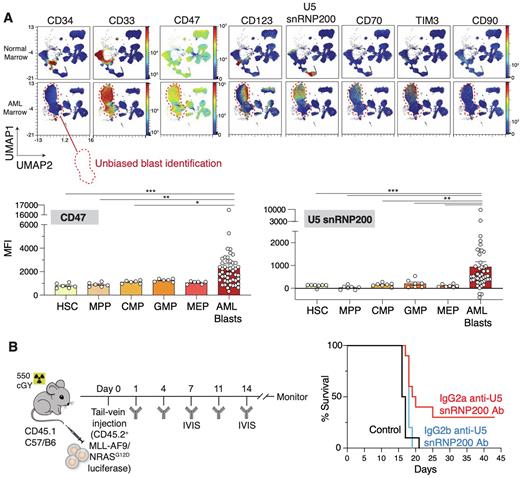Abstract
Numerous antibody-based immunotherapies are in development for AML including antibodies targeting CD47, CD70, CD123, CD33, and TIM3. However, systematic evaluation of the distribution of AML-associated antigens in combination with Fc receptors and the immune microenvironment required for antibody-mediated therapeutic responses have been limited. Additionally, efforts to maximize antibody Fc receptor engagement on immune effector cells in AML patients via Fc region engineering have not been explored.
Here we applied a custom 36-color flow cytometry panel tailored for AML patient bone marrow along with proteogenomic assessment via CITE-seq to simultaneously assess known and novel antibody target expression on AML cells, immune microenvironment, and Fc receptor expression across immune subsets. Application to samples from 7 age-matched healthy donors and 51 newly diagnosed AML patients allowed for unbiased identification of the malignant blast population via UMAP projection. Quantification of differential antigen expression on blasts and leukemic stem cells versus normal hematopoietic stem and progenitor cell (HSPC) subsets, identified that out of 9 AML putative antibody targets (CD123, TIM3, CD33, CD47, CD90, CD38, CD25, CD70, U5 snRNP200), only U5 snRNP200 is expressed on blasts but not normal HSPCs (Fig. A). Characterization of the distribution of Fc receptors revealed that AML patients exhibit reduced cell-surface activating Fc receptors (CD16, CD32A) on NK and non-classical monocytes with concomitant increases in inhibitory (CD32B) Fc receptors on monocytes and B-cells. Moreover, AML patients had fewer classical monocytes and type 2 conventional dendritic (cDC2) cells than normal age-match control marrow.
Given the unique cell surface expression of U5 snRNP200 on AML blasts compared with normal HSPCs, we deeply interrogated the distribution of this marker throughout normal and malignant hematopoiesis. While U5 snRNP200 expression was not seen on normal HSPCs, U5 snRNP200 was present on mature B-cells and a subset of NK cells in normal adult human and mouse hematopoietic cells. U5 snRNP200 is an RNA helicase which is an essential conserved component of the spliceosome. Its known function is limited to the nucleus and it is therefore unexpected that it would be expressed on the cell surface. To rigorously confirm expression of U5 snRNP200 on the cell membrane, we knocked in a HaloTag at the N-terminus of the locus encoding U5 snRNP200 within K562 cells and traced expression of tagged endogenous U5 snRNP200 protein across cellular compartments. This clearly revealed cell surface localization of the full-length protein on the surface of AML cells.
We next conducted genome-wide CRISPR screens in two human AML cell lines to identify regulators of surface U5 snRNP200 expression. In both cell lines, the top gene required for cell surface U5 snRNP200 expression was CD32A. CRISPR knockout of CD32A in U937 cells reduced U5 snRNP200 surface expression, while restoration of CD32A rescued U5 snRNP200 surface expression.
AML-associated expression of U5 snRNP200 was present on a number of syngeneic immunocompetent mouse models of AML including MLL-AF9, RN2 (MLL-AF9 + NRAS G12D), transgenic EVI1 rearranged/SF3B1K700E mutant, and Tet2/Zrsr2 double knockout mice. To test the therapeutic potential of targeting cell surface U5 snRNP200, we engineered several anti-murine U5 snRNP200 antibody variants featuring modified Fc regions to assess the possible roles of engagement of Fc receptors on immune cell subsets to enhance AML cell killing. In both the RN2 and EVI1/SF3B1 mutant models, anti-U5 snRNP200 antibodies featuring the Fc region modified to engage activating Fc receptors and induce antibody-dependent cellular cytotoxicity (IgG2a) provided superior survival benefit compared to IgG1 or IgG2b U5 snRNP200 antibodies or a mutant IgG1 antibody (IgG1 D265A) which does not bind Fc receptors (Fig. B).
These data provide a high-density roadmap of the distribution of known and novel AML-associated antigens together with the Fc receptor distribution and immune microenvironment in AML. The results motivated discovery of a novel antibody-therapeutic targeting aberrant cell-surface U5 snRNP200 and research into mechanisms for cell surface trafficking of U5 snRNP200.
Disclosures
Hogg:AbbVie: Current Employment. Abdel-Wahab:H3B Biomedicine, LOXO Oncology, and Nurix Therapeutics: Research Funding; Envisagenics Inc., AIChemy, Harmonic Discovery Inc., and Pfizer Boulder: Membership on an entity's Board of Directors or advisory committees; H3B Biomedicine, Foundation Medicine Inc, Merck, Prelude Therapeutics, and Janssen: Consultancy.
Author notes
Asterisk with author names denotes non-ASH members.


This feature is available to Subscribers Only
Sign In or Create an Account Close Modal